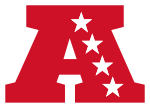American Football Conference facts for kids

American Football Conference logo
(2010–present) |
|
| Formerly | American Football League (AFL) |
|---|---|
| League | National Football League |
| Sport | American football |
| Founded | 1970 |
| No. of teams | 16 |
| Most recent champion(s) |
Kansas City Chiefs (5th title) |
| Most titles | New England Patriots (11 titles) |
The American Football Conference (AFC) is one of the two main groups of teams in the National Football League (NFL). The NFL is the top professional American football league in the United States.
The AFC and the other group, the National Football Conference (NFC), each have 16 teams. These teams are organized into four smaller groups called divisions. Both the AFC and NFC were created in 1970. This happened when the National Football League and the American Football League (AFL) joined together.
When they merged, all ten AFL teams became part of the new AFC. Three teams from the old NFL also joined the AFC. The remaining thirteen NFL teams formed the NFC. Over the years, more teams have joined, and some divisions have changed. Now, both conferences have 16 teams each.
The Kansas City Chiefs were the AFC champions for the 2024 season. They won their fifth conference championship by beating the Buffalo Bills. However, they later lost Super Bowl LIX to the Philadelphia Eagles.
Contents
AFC Teams and Divisions
Just like the NFC, the AFC has 16 teams. These teams are divided into four groups, or divisions. Each division has four teams. The divisions are called East, North, South, and West.
| Division | Team | Location | Stadium | Ref(s) |
|---|---|---|---|---|
| East | Buffalo Bills | Orchard Park, New York | Highmark Stadium | |
| Miami Dolphins | Miami Gardens, Florida | Hard Rock Stadium | ||
| New England Patriots | Foxborough, Massachusetts | Gillette Stadium | ||
| New York Jets | East Rutherford, New Jersey | MetLife Stadium | ||
| North | Baltimore Ravens | Baltimore, Maryland | M&T Bank Stadium | |
| Cincinnati Bengals | Cincinnati, Ohio | Paycor Stadium | ||
| Cleveland Browns | Cleveland, Ohio | Huntington Bank Field | ||
| Pittsburgh Steelers | Pittsburgh, Pennsylvania | Acrisure Stadium | ||
| South | Houston Texans | Houston, Texas | NRG Stadium | |
| Indianapolis Colts | Indianapolis, Indiana | Lucas Oil Stadium | ||
| Jacksonville Jaguars | Jacksonville, Florida | EverBank Stadium | ||
| Tennessee Titans | Nashville, Tennessee | Nissan Stadium | ||
| West | Denver Broncos | Denver, Colorado | Empower Field at Mile High | |
| Kansas City Chiefs | Kansas City, Missouri | Arrowhead Stadium | ||
| Las Vegas Raiders | Paradise, Nevada | Allegiant Stadium | ||
| Los Angeles Chargers | Inglewood, California | SoFi Stadium |
How the Season Works
| POS | AFC East | AFC North | AFC South | AFC West |
|---|---|---|---|---|
| 1st | Bills | Ravens | Texans | Chiefs |
| 2nd | Dolphins | Steelers | Colts | Chargers |
| 3rd | Jets | Bengals | Jaguars | Broncos |
| 4th | Patriots | Browns | Titans | Raiders |
| POS | NFC East | NFC North | NFC South | NFC West |
| 1st | Eagles | Lions | Buccaneers | Rams |
| 2nd | Commanders | Vikings | Falcons | Seahawks |
| 3rd | Cowboys | Packers | Panthers | Cardinals |
| 4th | Giants | Bears | Saints | 49ers |
The NFL season has 17 games for each team. The schedule is set using a special formula. Each AFC team plays the other teams in their own division twice. This means one game at home and one away.
They also play eleven other games. Three of these games depend on how well the team did last season. The other eight games are against teams from two different NFL divisions. These divisions change each year. For example, in the 2023 season, teams in the AFC West played against every team in the AFC East and NFC North. This way, teams play against many different opponents.
At the end of each season, the four division winners from the AFC go to the playoffs. Three other teams, called wild cards, also make it. These are the teams with the best records that didn't win their division.
The AFC playoffs end with the AFC Championship Game. The winner gets the Lamar Hunt Trophy. Then, the AFC champion plays against the NFC champion in the Super Bowl.
History of the AFC
When the AFL and NFL merged for the 1970 NFL season, they had to decide which teams would be in each new conference. The NFL President, Art Modell, who owned the Cleveland Browns, suggested that three NFL teams move to the AFC. This would make both conferences have the same number of teams.
It was a big discussion because no NFL teams wanted to move to what was seen as a "junior" league. However, Modell, along with Art Rooney (owner of the Pittsburgh Steelers) and Wellington Mara (owner of the New York Giants), worked out a deal. Modell offered to move his Browns team. Rooney, who didn't want to lose his team's rivalry with Cleveland, agreed to move the Steelers. The owner of the then-Baltimore Colts, Carroll Rosenbloom, also agreed.
So, the Cleveland Browns, Pittsburgh Steelers, and Baltimore Colts joined the ten former AFL teams. This formed the AFC in 1970. The two old AFL divisions, AFL East and AFL West, stayed mostly the same. The NFL's Century Division, which included the Browns and Steelers, became the new AFC Central.
Since the merger, five new teams have joined the AFC. Two teams have also left the AFC. This is how the AFC now has 16 teams.
- In 1976, the Seattle Seahawks and Tampa Bay Buccaneers joined the league. The Seahawks were briefly in the NFC, and the Buccaneers in the AFC. They switched conferences after one season. The Seahawks later moved back to the NFC in 2002.
- The Jacksonville Jaguars joined the AFC in 1995.
- Some teams have also moved to different cities. The Baltimore Colts moved to Indianapolis in 1984.
- In 1995, the Cleveland Browns tried to move to Baltimore. This led to a big disagreement. The owner, Art Modell, then created the Baltimore Ravens in Baltimore using the Browns' players. The original Browns team was put on hold and later brought back to Cleveland. The Ravens were treated as a new team.
- The Oakland Raiders moved to Los Angeles in 1982, then back to Oakland in 1995, and finally to Las Vegas in 2020.
- The San Diego Chargers moved back to Los Angeles in 2017 after being in San Diego for 56 years.
- The Houston Oilers moved to Tennessee in 1997 and became the Tennessee Oilers. Two years later, they changed their name to the Tennessee Titans.
- In 2002, the NFL added the Houston Texans to the AFC.
Since 2002, the divisions have mostly stayed the same, except for team moves.
Between 1995 and 2022, only 9 of the 16 AFC teams made it to the Super Bowl. The New England Patriots went 10 times, the Pittsburgh Steelers 4 times, and the Denver Broncos 4 times. The Baltimore Ravens and Indianapolis Colts each went twice. The Kansas City Chiefs went 3 times, and the Cincinnati Bengals, Las Vegas Raiders, and Tennessee Titans each went once.
In comparison, 13 of the 16 NFC teams made it to the Super Bowl during that same time. From 2001 to 2019, 17 of the 19 AFC champions in the Super Bowl had one of just three quarterbacks: Tom Brady, Peyton Manning, or Ben Roethlisberger.
AFC Logo Evolution
The first AFC logo looked a lot like the old AFL logo. But after the merger, a new AFC logo was quickly made. It had a bolder red "A" and six strong red stars around it. The NFL also made a logo for the NFC in 1970. It also used just the first letter and had three stars, representing its three divisions at the time.
The AFC logo stayed mostly the same from 1970 to 2009. In the 2010 NFL season, an updated AFC logo was introduced. The biggest change was removing two stars, leaving four stars to represent the four AFC divisions. These stars were also moved inside the letter "A," similar to the NFC logo, which also got an update at the same time.
Interestingly, the Kansas City Chiefs still often show the original AFL logo on their jerseys. The Chiefs are still owned by the family of Lamar Hunt, who founded the AFL.
Television Coverage
From 1970 to 1997, NBC showed the AFC's Sunday afternoon and playoff games. From 1998 to 2013, CBS was the main TV channel for the AFC. During those years, if an AFC team played an NFC team away from home, the game was shown on NBC or CBS.
Since 2014, a new rule allows some AFC games to be shown on Fox. This happens if an AFC team plays an NFC team at home, or for some games between two AFC teams. Since 1990, some AFC playoff games have also been shown on ABC or ESPN.
See also
 In Spanish: Conferencia Americana para niños
In Spanish: Conferencia Americana para niños
- AFC Championship Game
AFC Divisions
AFC Rivalries
AFC East
- Bills–Dolphins rivalry
- Bills–Patriots rivalry
- Bills–Jets rivalry
- Dolphins–Patriots rivalry
- Dolphins–Jets rivalry
- Jets–Patriots rivalry
AFC North
- Bengals–Ravens rivalry
- Bengals–Browns rivalry
- Bengals–Steelers rivalry
- Browns–Ravens rivalry
- Browns–Steelers rivalry
- Ravens–Steelers rivalry
AFC South
- Colts–Jaguars rivalry
- Colts–Texans rivalry
- Colts–Titans rivalry
- Jaguars–Texans rivalry
- Jaguars–Titans rivalry
- Texans–Titans rivalry
AFC West
- Broncos–Raiders rivalry
- Broncos–Chiefs rivalry
- Broncos–Chargers rivalry
- Chargers–Raiders rivalry
- Chargers–Chiefs rivalry
- Chiefs–Raiders rivalry
Interdivisional
- Bills–Chiefs rivalry
- Bills–Titans rivalry
- Broncos–Patriots rivalry
- Broncos–Steelers rivalry
- Colts–Patriots rivalry
- Dolphins–Raiders rivalry
- Raiders–Steelers rivalry
- Patriots–Ravens rivalry
- Patriots–Steelers rivalry
- Steelers–Titans rivalry
- Ravens–Titans rivalry
AFC Television Network
- NFL on NBC (1970–1997)
- NFL on CBS (1998–present)



